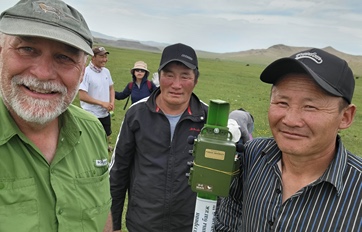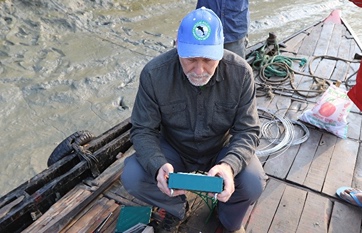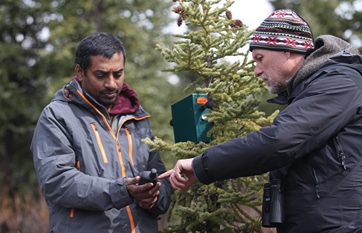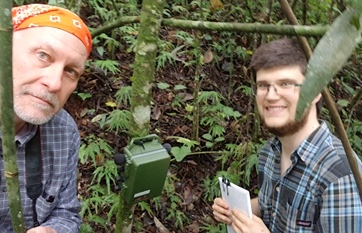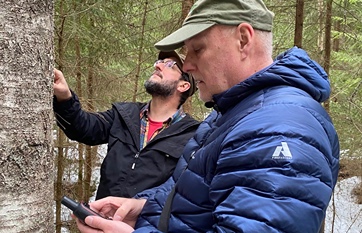The sound of the world
Professor Bryan Pijanowski’s new book underlines the importance of sound to understanding changing landscapes
It’s summer, but Bryan Pijanowski is as busy as ever. He’s working on several grant proposals and a couple of high-profile scientific articles, and is gathering videos and audio recordings for a possible documentary about climate change’s impact on biodiversity. He also travelled to Las Vegas, where his soundscape recordings from Mongolia, Bangladesh, Argentina, and Tanzania were projected inside of the Sphere, the brand-new 18,600-seat, 186,000-speaker auditorium hovering like an alien planet just off the Strip. The aim of this trip? To bring the sounds of planet Earth to audiences in the purest sound production building ever constructed.
View his Recordings at the Sphere
And then there’s his new book, all 509 pages of it. Principles of Soundscape Ecology, published by the University of Chicago Press in June, is a textbook introduction to soundscape ecology, the field Pijanowski helped pioneer– the study of landscapes through sounds. Pijanowski, a professor of forestry and natural resources, and director of Purdue’s Center for Global Soundscapes, studies how changes in soundscapes over time – the fall of rain on a forest canopy, the creaking of ice inside a glacier, the roar of airplanes overhead – can teach us about the health of our ecosystems.
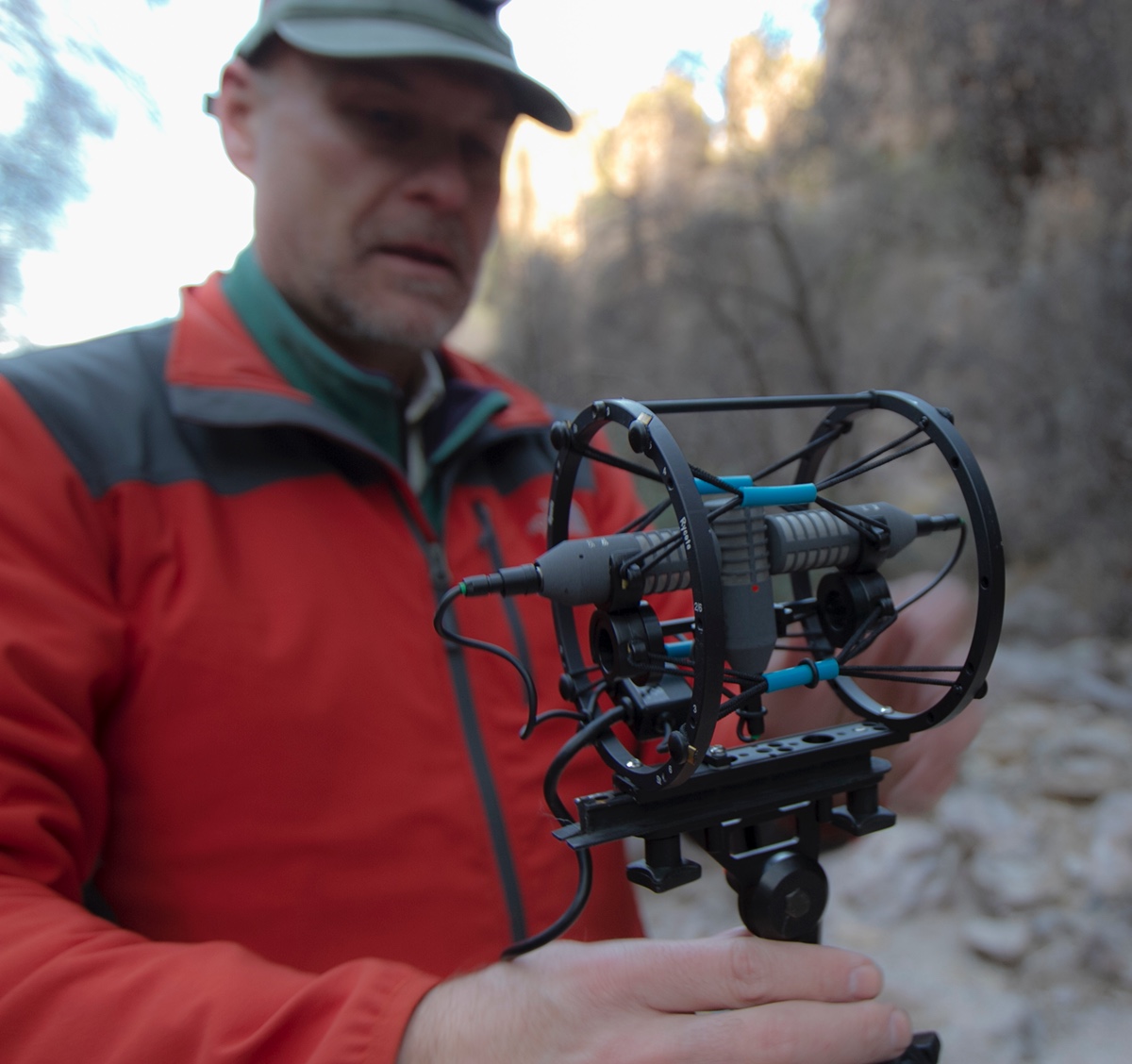 “Sound is ubiquitous, but by golly we’ve kind of ignored it as a way of studying the earth,” Pijanowski says. “So I’m glad we’re moving forward.”
“Sound is ubiquitous, but by golly we’ve kind of ignored it as a way of studying the earth,” Pijanowski says. “So I’m glad we’re moving forward.”
The book’s genesis dates to 2015, when the University of Chicago Press reached out to Pijanowski to ask if he’d been interested in such a project. At the time, he was too busy making his IMAX/giant screen educational film – Global Soundscapes: Mission to Record the Earth – which was finished in 2019.
“I said yes in January 2020, signed the paperwork, and I was off and running,” Pijanowski says.
Pijanowski’s goal with the book was to both grow and define the scholarship in the field of soundscape ecology, and to create an introduction for those interested in the subject. “I wanted something I could give graduate students when they walked in the door on day one,” he says. “A guide for how to think about sound in an ecological context.”
The book begins by defining soundscape ecology. It then goes through an intellectual history of the field, discusses important background concepts like the physics of sound, and brings in the various disciplines which bear on the area: ethnomusicology, data science, conservation biology.
For Pijanowski, the physics of sound chapter was by far the most difficult to write. He is, after all, a biologist and not a physicist by training. So he reached out to the wider community for help.
“I have some friends here in the physics department at Purdue, so we’d get on Zoom and I’d say, ‘Hey, can you tell me how do you teach sound in your intro physics course?’” he says.
He even reached out to the CEO of the company that produces some of the sensors he uses in recording, to ask for some guidance on technical issues.
The vast project, written during the pandemic, took up not just mental, but physical space as well.
“I took over half of our family room with bins, color-coded bins – every chapter was a different color, with print-outs of key articles,” he says. “It was a messy family room for three years!”
Much of the book’s first chapter is concerned with soundscape ecology’s applications. Pijanowski condenses these applications into a handful of main areas. First, as he explains, soundscape ecology can help us understand biodiversity and trends in biodiversity better than before. Take, for example, a bird survey, traditionally used to map out bird populations. Such surveys are traditionally very labor-intensive – researchers need to literally go out and look for birds themselves. But imagine now setting up passive acoustic recorders in the trees, which allows researchers to record the sounds of any birds in the area over any period of time, and then use AI to determine the species.
“We can map out biodiversity in amazing detail, especially through time,” Pijanowski says. “It’s going to help us understand how biodiversity is changing on the planet.”
Another major use for soundscape ecology is in understanding how sounds in the living environment affect humans, and how we might change them for the better.
“Many noises and sounds from the cities are very unhealthy,” Pijanowski says. “Understanding the concept of soundscape helps us think about changing our building footprints, planning for city parks and so on, to improve living spaces for people.”
Sounds are also used by many indigenous cultures as a form of ecological knowledge, Pijanowski says. For example, Mongolian herders have a tradition of going to their parents’ birthplaces and singing about the sounds they hear using a method called ‘throat singing.’ They tune themselves to the sounds of the rivers at the birthplaces, as a way of paying homage to their parents as well as blessing the spirits and the land.
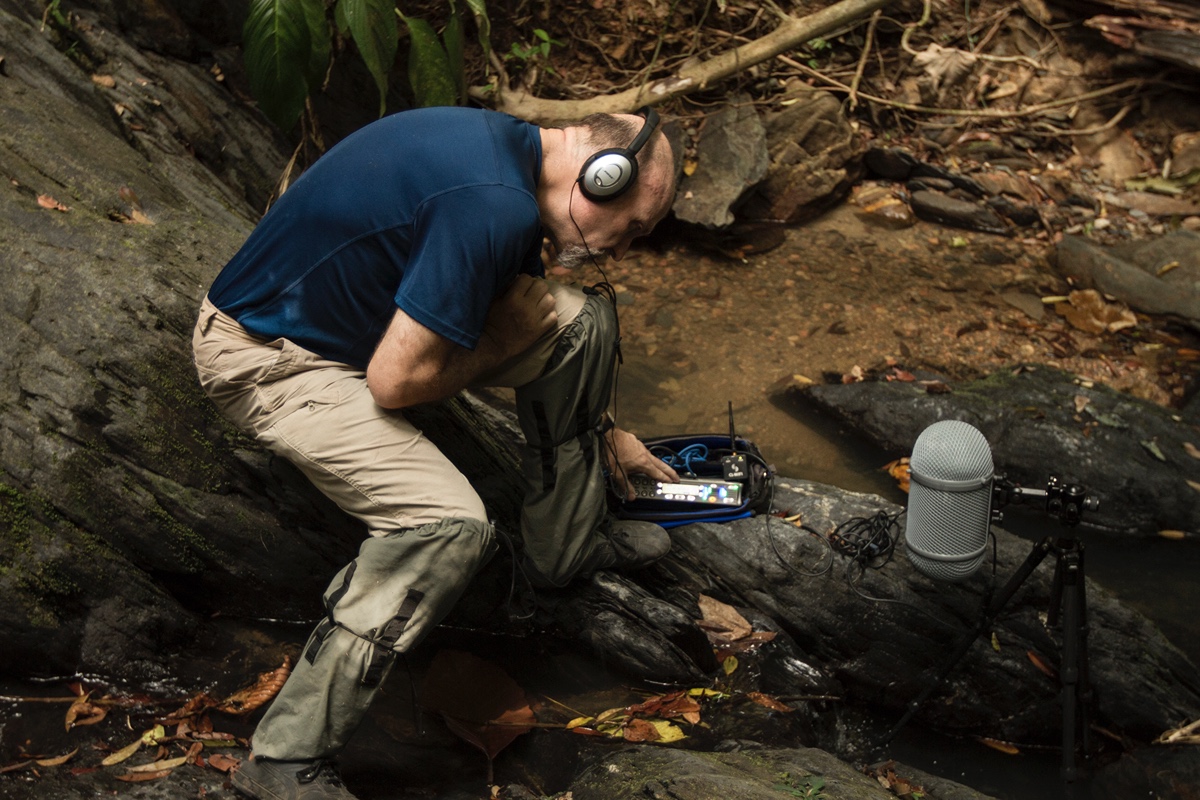 Pijanowski was in Borneo recording the sounds of a river that flows through complex rock formations. He was interested in the sonic structures related to structure of the stream channels.
Pijanowski was in Borneo recording the sounds of a river that flows through complex rock formations. He was interested in the sonic structures related to structure of the stream channels. “But if climate change is going the way it’s going, those streams are drying up,” Pijanowski says.
So, paying attention to the changes in the songs is a way of monitoring the streams. And the changes in the streams are impacting the way the people relate to their ancestors and to the land.
“This integration is truly important to understand,” Pijanowski says.
Unsurprisingly, Pijanowski’s work has crossed traditional disciplinary boundaries. His colleagues on soundscape ecology projects include physicists, musicians, artists, anthropologists, ethnomusicologists, healthcare professionals, and biomedical engineers, among others.
“This is a unique topic to go as far transdisciplinary as you can ever go,” he says. “I did strive to make this book a transdisciplinary approach to thinking about sounds.”
One of these colleagues is Jennifer Post, an ethnomusicologist at the University of Arizona. Post says she’d heard of Pijanowski’s work as early as 2011, but was initially skeptical of his approach, which she saw as using a biologist’s lens on anthropological questions. But then, in 2016, they had the chance to be on a panel together. She brought up some of her concerns, and found he was curious and open to feedback.
“Less than a year later, we were in Mongolia doing work together,” she says.
They’ve been working together ever since, looking at how sound and soundscape knowledge should be recognized across the disciplines. They shared an NSF grant in 2020, and are waiting to hear whether they’ve been awarded another.
Post expects that the book will be useful to students and researchers at all levels, and across many disciplines. She herself plans to use a section of the book in an upcoming course on music and climate change.
“It’s moving into the world at a really critical time,” she says. “Understanding sound and soundscapes is a key to how we are going to manage climate change and environmental degradation.”
Laura Zanotti, a Purdue anthropologist who has worked with Pijanowski for years, says his focus on interdisciplinary approaches makes the book valuable far beyond the soundscape ecology community.
“What’s thrilling about the book is that a lot of people are trying to figure out how to do meaningful interdisciplinary work to address global grand challenges, and this provides a really novel and insightful road map to do so in a way that centers sound and sonic practices,” she says. “So even if sound isn’t your thing, it still has many possibilities to offer.”
Pijanowski expects to do some events surrounding the book’s publication this summer. He is also putting together a podcast to help students and researchers navigate the book. It will have four episodes, one for each section of the book. He plans to have it done before the start of the fall semester, so it can be used in classes.
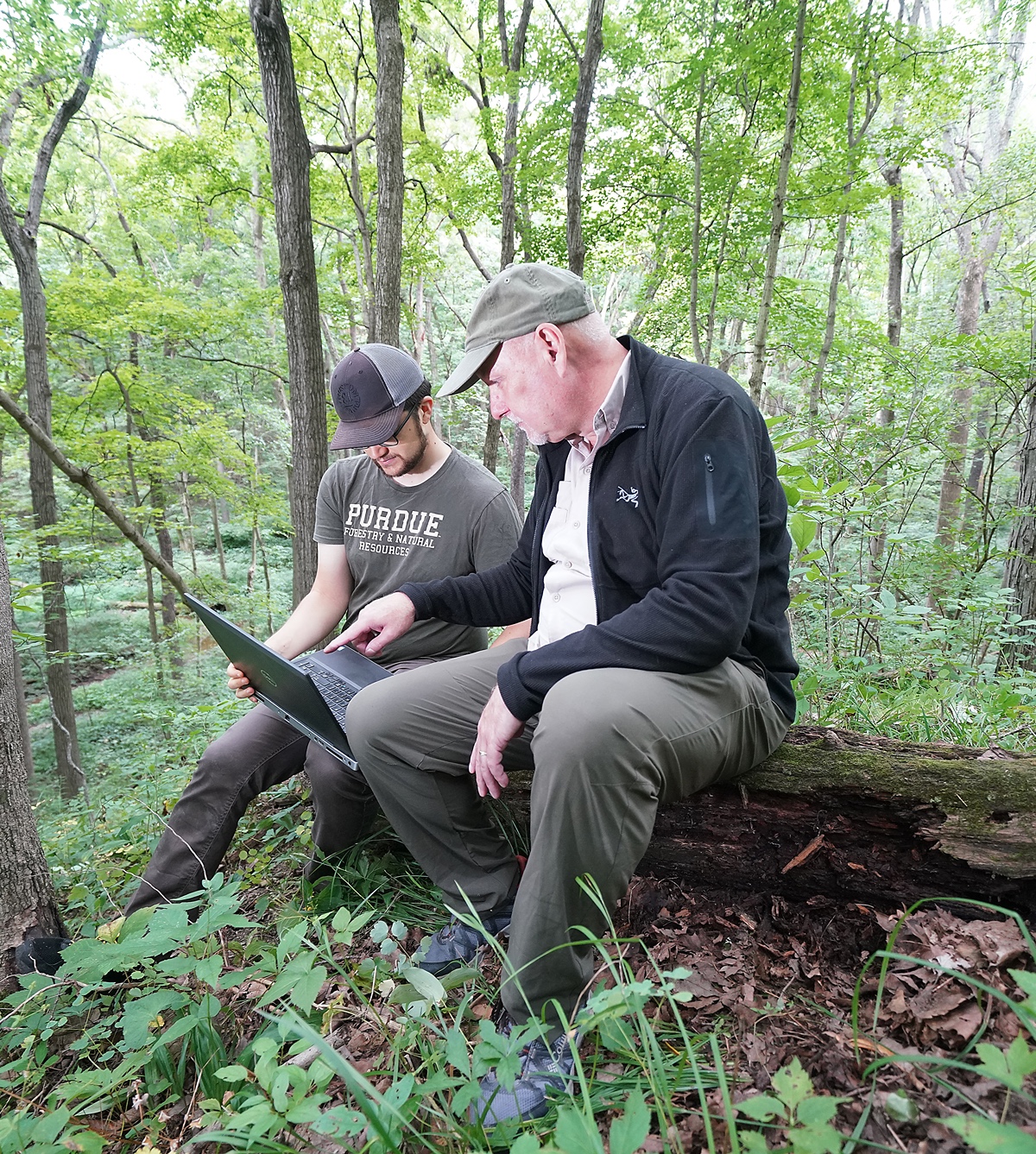 Moving forward, Pijanowski is continuing what he calls his “ambitious Mission to Record the Earth project” – a career goal to study the soundscapes of every major ecosystem on earth. As incredible as this might sound, he’s already recorded 28 of the 32 major ecosystems. The four that remain are the coastal deserts like the Atacama Desert in Chile, the spiny forest of Madagascar, the temperate rainforests of the Pacific Northwest or Tasmania, and the polar tundra that includes Siberia, northern Canada or Antarctica.
Moving forward, Pijanowski is continuing what he calls his “ambitious Mission to Record the Earth project” – a career goal to study the soundscapes of every major ecosystem on earth. As incredible as this might sound, he’s already recorded 28 of the 32 major ecosystems. The four that remain are the coastal deserts like the Atacama Desert in Chile, the spiny forest of Madagascar, the temperate rainforests of the Pacific Northwest or Tasmania, and the polar tundra that includes Siberia, northern Canada or Antarctica.
“There’s no place on earth where there isn’t sound,” he says.
Though Pijanowski admits that his travel experiences have given him “over the top amazing” baseline for what soundscapes can be, he still finds some Purdue-area soundscapes lovely.
“Martell Forest [Purdue Forestry’s research forest, 8 miles west of campus] in late spring, early in the morning is pretty extraordinary,” he says. “I would hear a lot of neotropical migratory birds that have been overwintering in Central or South America. Warblers have beautiful melodies with interesting structure. There’s the wind through the trees, if there are enough leaves out, which provides a backdrop to the songs of the birds. Maybe the spring peepers calling. It’s very calming.”
Ultimately, Pijanowski’s goal is to bring the sounds of nature to as many people as possible. That could mean reading his book, listening to his recordings, or seeing his film. Or it could simply mean going out to a park or your backyard and “just listening.”


